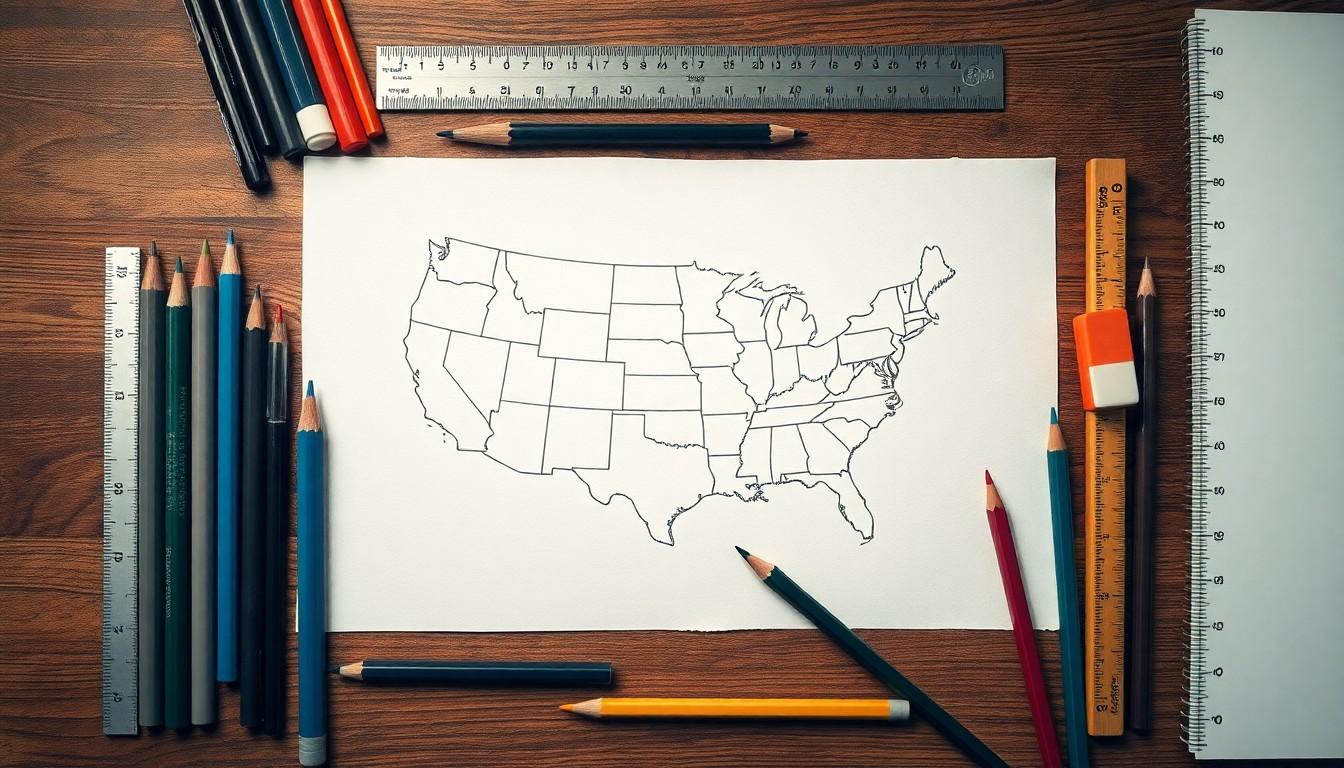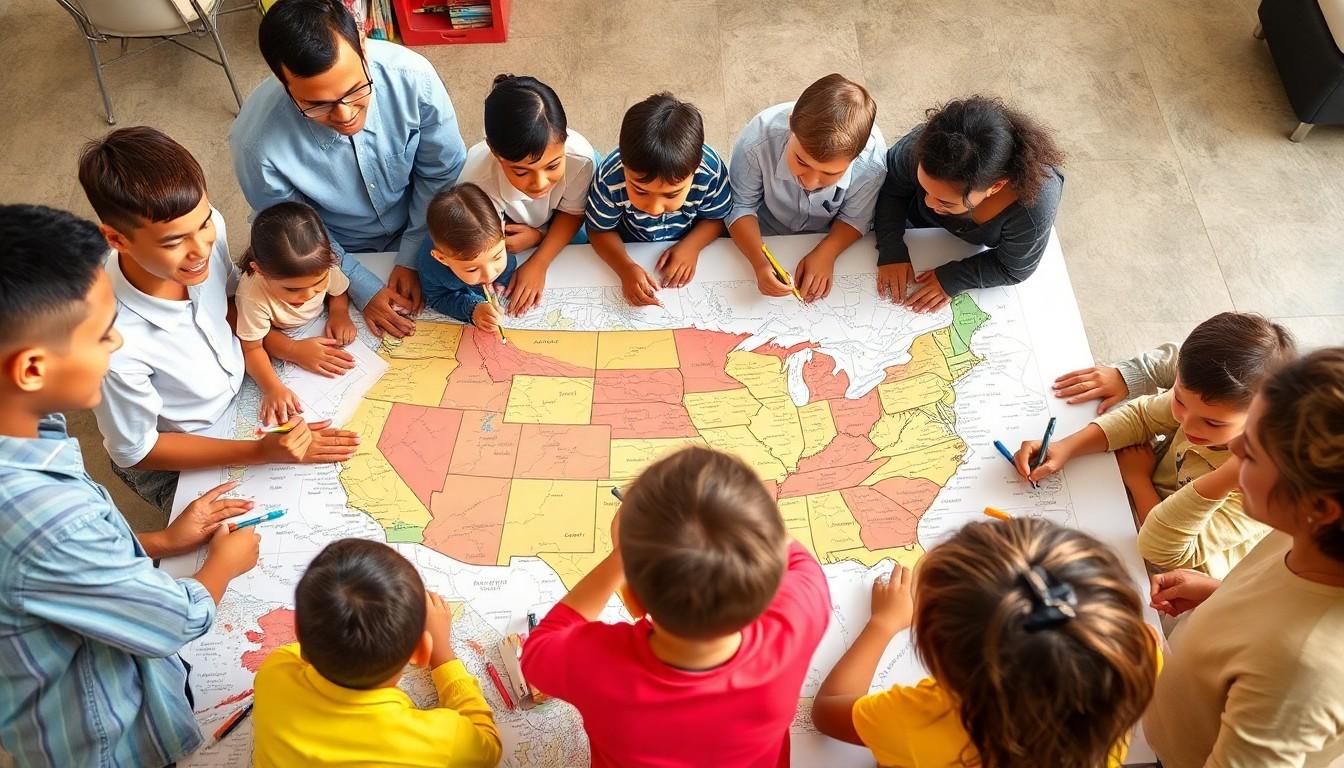Drawing a map of the USA might sound like a task for seasoned cartographers or geography whizzes, but it’s actually an adventure anyone can embark on. Imagine the satisfaction of sketching out the sprawling states, from the sun-soaked beaches of California to the bustling streets of New York. Not only is it a fun way to brush up on geography, but it also offers a chance to unleash creativity and maybe even discover a hidden talent for art.
USA Map Drawing
Drawing a map of the USA offers a unique way to engage with geography. The process allows individuals to explore various states and their features. Artists and non-artists alike find pleasure in capturing California’s beaches or New York’s streets.
Various techniques assist in map drawing. Starting with basic outlines helps establish state boundaries. Next, adding details like rivers and mountains enhances the overall representation. Advanced techniques include using color to differentiate states or marking significant landmarks.
Crafting a USA map can improve knowledge of geography. Associating states with their geographic locations aids in retention. At the same time, it provides an opportunity to practice fine motor skills.
Different tools can be utilized for creating maps. Pencils, markers, or digital drawing software offer distinct advantages. Markers provide vibrant colors for highlighting states, while digital tools allow for easy corrections.
Participants of all ages can enjoy drawing a USA map. Children can learn through play, while adults can explore their artistic sides. Workshops and online tutorials offer helpful guidance, making the process even more accessible.
Drawing a map of the USA serves as a fun educational tool. Individuals experience joy in creating their own interpretations of the country. This engaging activity celebrates both artistic expression and geographical awareness.
Tools And Materials Needed

Various tools and materials enhance the experience of drawing a map of the USA. Selecting the right items makes the process both enjoyable and effective.
Traditional Tools
Pencils serve as the foundation for sketching outlines. Markers add vibrant details, making states and landmarks stand out. Rulers help ensure straight lines, providing structure to borders. Erasers allow for adjustments, promoting accuracy as mistakes occur. Colored pencils lend creativity, enabling the incorporation of unique features. Paper, whether textured or smooth, influences the drawing experience, offering a canvas for expression. Keeping these traditional tools organized supports a seamless workflow, allowing for immediate access during the mapping process.
Digital Tools
Tablets and styluses provide precision in digital drawings. Software applications, such as Adobe Illustrator and Procreate, offer advanced features for creating intricate maps. Online resources deliver templates and images, aiding in design inspiration. Graphic design tools enable users to incorporate layers, enhancing detail and depth. Using digital platforms allows for easy modifications, supporting creativity while streamlining the mapping process. Cloud storage ensures that all creations remain accessible, facilitating sharing and collaboration on projects.
Step-By-Step Guide To USA Map Drawing
Drawing a map of the USA involves a structured, enjoyable process. Following specific techniques can enhance both the accuracy and artistic appeal of the map.
Basic Shapes And Proportions
Begin by sketching simple shapes to represent the USA’s states. Rectangles and triangles form the foundational outline. Identifying proportions ensures more accurate placements of states. For example, the eastern seaboard features narrower states than those found in the west. Start from the top, positioning states like Maine and Florida, then gradually work inward. Maintaining relative size helps users visualize distances and positions accurately, which provides a clearer overall map.
Adding Details And Features
Once the basic shapes are defined, it’s time to enhance the map with features. Adding rivers, mountains, and cities brings the map to life. Begin with major landmarks, such as the Mississippi River or the Rocky Mountains, to anchor the design. Utilize different line styles to differentiate landforms and water bodies. Incorporate icons or symbols for significant locations, such as national parks or capital cities. Colors can highlight state boundaries and features, making the map more visually appealing. This careful detailing transforms a basic outline into an informative and engaging representation of the USA.
Tips For Improving Your USA Map Drawing Skills
Improving map drawing skills involves practice and awareness of common pitfalls. Various techniques can help enhance this artistic endeavor, making the process enjoyable.
Practice Techniques
Consistent practice leads to improvement in map drawing. Incorporating tracing paper aids in understanding the shapes of states. Using references like online maps provides accurate outlines for replication. Experimenting with different styles encourages creative expression. Focusing on one state at a time simplifies the learning process and builds confidence. Engaging in group activities or workshops promotes peer feedback and collaboration, enhancing the learning experience.
Common Mistakes To Avoid
Neglecting proper proportions results in inaccurate representations of states. Overlooking the importance of starting with basic shapes complicates the drawing process. Inconsistent line styles may lead to confusion when identifying different features. Ignoring the scale can cause misrepresentation of distances between landmarks. Rushing through details often compromises overall quality. Recognizing these mistakes enables learners to refine their techniques and improve their map drawings.
Drawing a map of the USA is an engaging activity that combines creativity with education. It invites individuals to explore their artistic side while enhancing their geographical knowledge. Whether using traditional tools or digital platforms, the process can be tailored to suit any skill level.
With practice and the right techniques, anyone can create a vibrant and accurate representation of the states. This enjoyable endeavor not only fosters a deeper understanding of geography but also hones fine motor skills. Embracing this artistic challenge can lead to a rewarding experience that celebrates both learning and self-expression.

